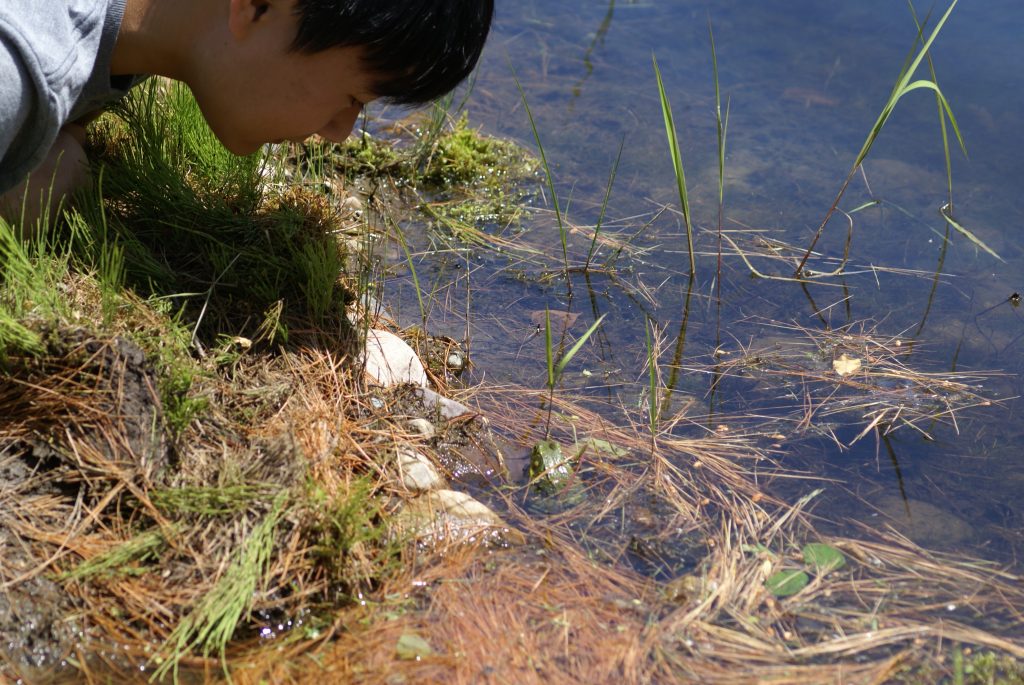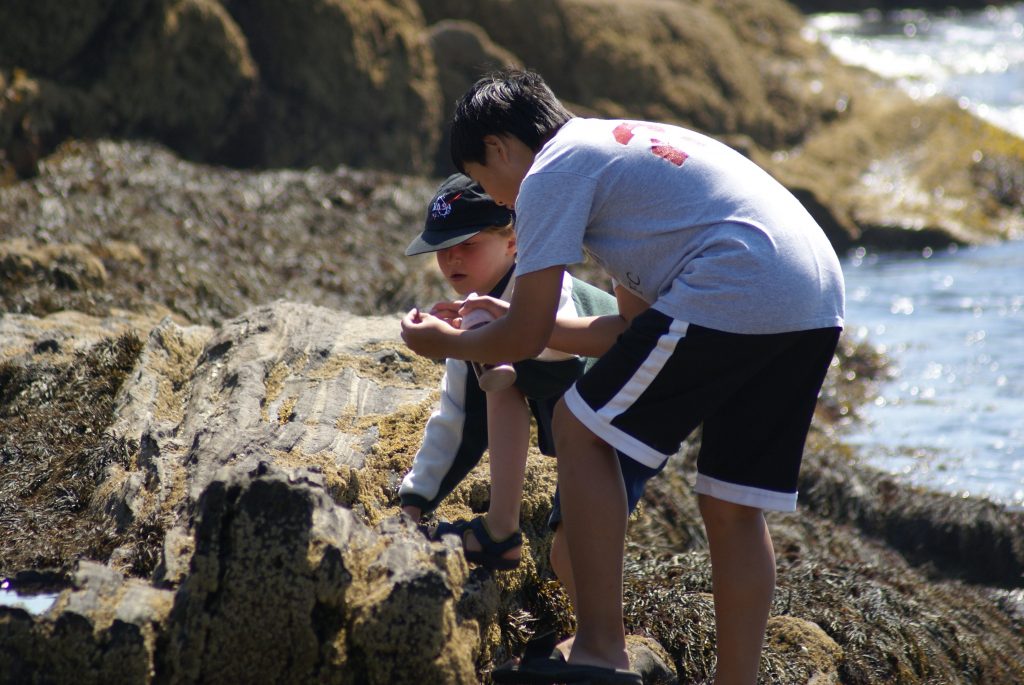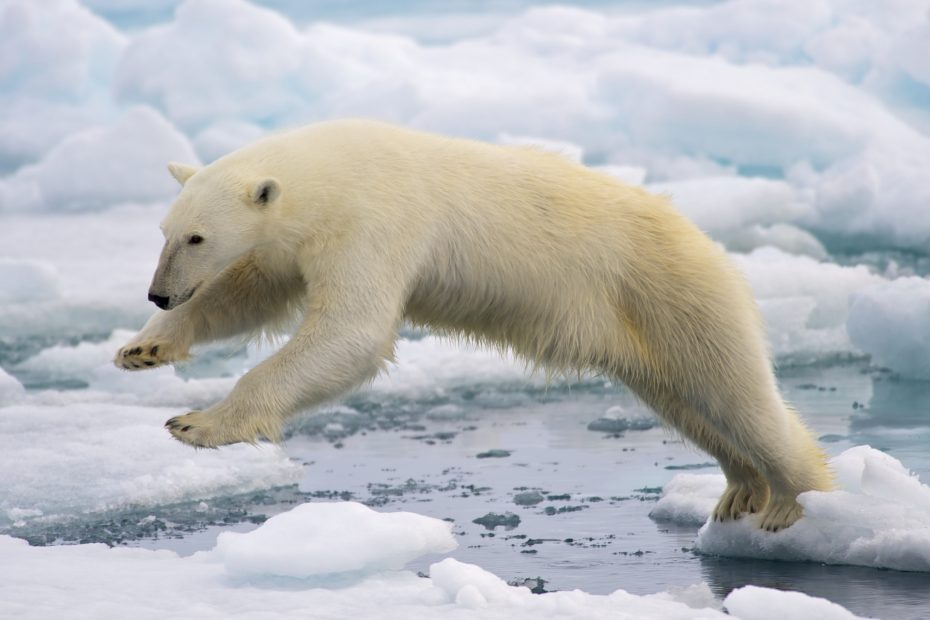By Tina Grotzer
Image: Arturo de Frias Marques / CC BY-SA
“What is the value of preserving and strengthening this sense of awe and wonder, this recognition of something beyond the boundaries of human existence? Is the exploration of the natural world just a pleasant way to pass the golden hours of childhood or is there something deeper?” -Rachel Carson, A Sense of Wonder
I grew up in a rural environment with woods and streams all around me. Others would say that we were poor, but I never felt impoverished. I climbed trees, explored the pond, got stuck in the mud, and jumped onto the gnarled, moss-covered roots in the middle of the creek to read a book. In those innocent days of green, and compelled by a sense of awe and wonder, I acquired the inclination to love and appreciate nature—to deeply care about it.
Later, as a teenager working at a nature camp for young children, I encouraged their inclination to care about nature but came to realize that caring about nature meant caring for it, and that required helping children to develop sensitivity to occasions when people could exercise that care. During our visits to a pristine woodland pond, the children could easily grasp the fragility of the micro-environment that they were observing. But they needed lots of help grasping the fragility in their everyday surroundings, such as the local birds which were decimated by neighborhood cats, the frogs which gathered in a parking lot where a vernal pool once existed, and the pine trees along the highways that were yellowing from atmospheric degradation.
These formative experiences led to the pursuit of a life-long set of questions that I have addressed in both my teaching and research. They are the following: “How do we take responsibility for the wonder and beauty of our planet and its inhabitants?”, “What enables us to make informed and morally thoughtful decisions in carrying out our responsibility?”, “How do we encourage environmentally ethical choices?”, and “What exactly are we hoping to help the next generation learn?” In addressing these questions, I have come to imagine children’s development as happening within a ring of concentric circles — of family, extended family, and local community –which, together, make possible a broadening out towards global citizenship.

Each circle holds connections and relationships that children learn to develop and navigate. Furthermore, children learn that they can apply what they learn at the level of one circle to the level of the next circle. For example, at the family and extended family levels, they may learn about sharing, not being wasteful, and being considerate of others, and then use what they have learned by doing the same at a local community level. In doing so, children’s developing patterns of engagement in their smaller circles come to support how they engage, as citizens, in broader circles of community. Therefore, thinking in terms of concentric circles can help us better understand how the supports at home for ethical environmental behavior provide a foundation for global ethical environmental behaviors later.
This thinking in terms of circles of ethical environmental behaviors paints a promising picture. But what happens as the circles get wider – as it does when faced with issues of environmental justice? Environmental justice is one of the defining issues of our time, and so, understanding environmental connections in our world is crucial to acting to show care. Without understanding those connections, we don’t connect our using plastic bags to sea creatures dying or our using fossils fuels to the plight of polar bears in the Arctic. Furthermore, when nature speaks, without making the connections, we cannot always hear. Why is this so? Why is it that achieving a global community of environmentalists who make the larger connections is much more complicated than we think it should be? The answer, it seems, has less to do with wonder, awe, and caring for the natural world and more to do with the inadequate ways we think about the natural world and what keeps our planet healthy. Let me explain.
My colleagues, Shari Tishman and David Perkins, have argued that effective thinking in general requires sensitivity, ability, and inclination. One must be sensitive to opportunities to engage, have the ability (reasoning strategies and information) to do so, and the inclination to follow through. Sensitivity, ability,
and inclination are, then, essential to becoming an effective environmental steward. These three features of a dispositional approach to thinking account for the times when we fail to act when we should act – because we lack sensitivity to when the occasion calls for action, lack the ability to think in ways needed to understand, or do not follow through on what we perceive and understand.
Cognitive and neuroscience research suggests that human cognitive architecture is not particularly well adapted for perceiving, attending to, and reasoning about complexity. This creates significant challenges in developing the sensitivity, ability, and inclination of an earth steward. For instance, we tend towards efficiency in making causal connections, so we don’t typically trace out extended, domino-like results of our actions – as when we save when choosing the cheaper version of an appliance without realizing that it might later on incur more waste than the more expensive version – as it breaks down and needs replacement. Furthermore, we prioritize obvious causes and effect, so we attend to pollution that blocks the sun and that we can see in the sky but not to the invisible carbon pollution that is there even on clear, sunny days. And our conceptions of intentionality and agency downplay outcomes that are non-intentional or that spread across many actors such that we don’t feel responsible. In a similar vein, we prioritize allocating resources to combatting terrorism instead of prioritizing climate action.

As our concentric circles broaden, the challenges shift and change. The impacts of our actions become less apparent to us because they play out on a much bigger and longer scale. This makes our accountability harder to discern. Going back to a previous example, we likely would care about polar bears dying if we knew about them, kept them in our minds, and remained sensitive to the moments when our actions impact polar bears. But polar bears being far away in the North means we don’t keep them in our minds. In a similar way, the connection to non-local groceries that become meals on our plates and our driving to the store – their adding CO2 to the atmosphere — is beyond the attentional frames of most of us, and so we don’t see how they connect to climate change. Furthermore, often the impacts of our actions are a result of distributed, collective actions. The emergent outcomes are not directly traceable to our own individual actions, but rather to the synergistic effects of collective actions so we fail to see them.
These broadened circles of interaction challenge the very ways that we conceptualize cause and effect and our agency in the world. They impact our sensitivity (or lack of sensitivity) to opportunities when we need to reason about our behaviors in order to act in environmentally responsible ways. This challenges our ability to reason in ways that have impact. Without a developed way of conceptualizing cause and effect and our agency in the world, there can be no trigger to motivate us to act and no effective path for us to navigate.
So how do we get beyond good intentions and a simple focus on just cultivating wonder and care? Here are some steps one can take based upon understanding the challenges outlined above:
- Realize the importance of teaching for sensitivity, ability, and inclination. I recall a day when my twins were ten. I had come home and was turning off lights, closing doors, and lowering thermostats. As I passed by, they called out, “Mom, play this computer game with us. We get points each time we do something good for the environment.” “But I am already playing,” I said as I turned off another light, I added, “for real!”. Their puzzled faces shifted, as they got it, and then we talked about how the game would be better if it encouraged kids to play “for real” by actually doing something good for the environment.
- Help the next generation develop a vocabulary for handling complex causal concepts.1 Our language can help children and youth grasp complex interactions, but only by inviting them to adopt language to address non-linear structures that are cyclic, extended domino-like, or escalating. We can help them acquire such language by applying it to students’ own lived experiences, such as when a meme goes viral on-line and causes a kind of “domino effect”, or when a rumor spreads and triggers myriad untruths that are beyond the control of those who started the rumor. These everyday experiences of young people can be used as meaningful analogies for understanding complex environmental events and problems.
- Use curriculum resources that offer children the opportunity to engage in problem-finding and problem-solving as they learn environmental science. Increasingly, inquiry-based and Problem-Based Learning (PBL) curricula are available to help learners investigate environmental issues. These curricula can provide great ways to foster ability and inclination to address and solve environmental problems. And instead of giving them a problem and telling them to solve it, curriculum resources can invite learners to engage in problem-finding so that they develop sensitivity to detecting environmental issues. The EcoMUVE and EcoXPT curricula for middle schoolers, developed by the EcoLEARN team at the Harvard Graduate School of Education, provide two examples of curricula designed to engage students in problem-finding.2
- Help learners to be metacognitive about their human cognitive tendencies and help them employ strategies to address those tendencies. While students, on their own, find it hard to change their everyday habits of thinking, on occasion, they can be helped to step back, reflect, and make purposeful choices to change their thinking so as to better understand the natural environment and what needs to happen to improve care for the natural environment.
These four steps can help support generations of earth stewards. They tell us that though it is important to teach the young to love nature, it is equally important that we empower them to engage in environmental reasoning using the background knowledge to support deep thinking, all the while being sensitive to those opportunities, both large and small, when their choices can make a difference.
…………………………………………………………
1 See Grotzer, T.A. (2012). Learning Causality in a Complex World: Understandings of Consequence. Lanham, MD:
Rowman Littlefield.
2 See the EcoLEARN Projects for an example, available at: https://ecolearn.gse.harvard.edu/ This work was
supported by the National Science Foundation (NSF), Grant No DRK12 1416781 and the Institute of Education
Sciences (IES), U.S. Department of Education, Grant No. R305A080514. All opinions, findings, conclusions or
recommendations expressed here are those of the authors and do not necessarily reflect the views of the NSF or
IES.
I dedicate this article to James J. McCarthy (1944-2019), Professor of Biological Oceanography at Harvard
University, former President of the American Association for the Advancement of Science (AAAS), Co-chair of the
International Panel on Climate Change (IPCC) Working Group II. I feel fortunate to have witnessed his intelligence, tireless dedication, and his deep and abiding love for nature, and particularly the twinkle in his eye when he spoke of it.
Tina Grotzer is a principal investigator at Harvard Project Zero and leading researcher in environmental education and fostering the development of systems thinking.


This article gives clear idea in favor Thanks for the Appreciation
Thank you so much for the advice. Great read
Thanks for this amazing Keep supporting us for more
Great post thanks for sharing
I love how detailed and well-researched your posts are